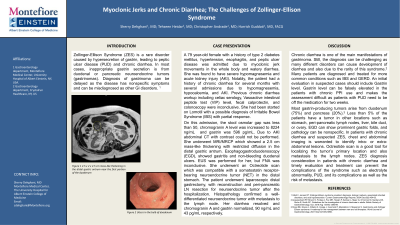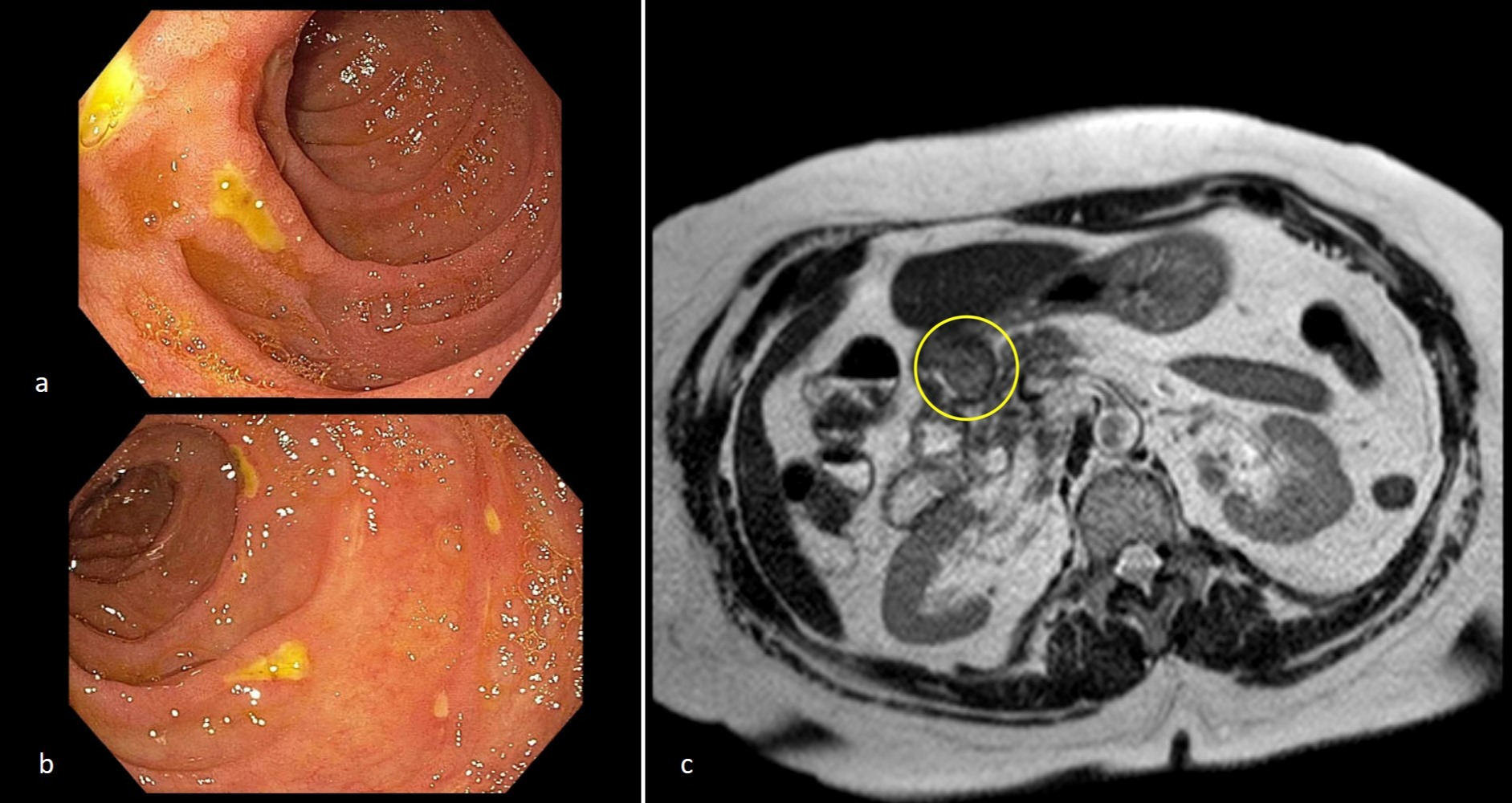Back


Poster Session B - Monday Morning
Category: Stomach
B0734 - Myoclonic Jerks and Chronic Diarrhea; The Challenges of Zollinger-Ellison Syndrome
Monday, October 24, 2022
10:00 AM – 12:00 PM ET
Location: Crown Ballroom

Has Audio

Sherry Dehghani, MD
Montefiore Hospital / Albert Einstein College of Medicine
Bronx, NY
Presenting Author(s)
Sherry Dehghani, MD1, Tehseen Haider, MD2, Christopher Andrade, MD3, Harish Guddati, MD, 2
1Montefiore Hospital / Albert Einstein College of Medicine, Bronx, MN; 2Montefiore Medical Center, Bronx, NY; 3Montefiore Wakefield Hospital, Bronx, NY
Introduction: Zollinger-Ellison Syndrome (ZES) is a rare disorder caused by hypersecretion of gastrin, causing peptic ulcer disease (PUD) and diarrhea. In most cases, inappropriate gastrin secretion is from duodenal or pancreatic neuroendocrine tumors (gastrinoma). Diagnosis of gastrinoma can be delayed as symptoms are nonspecific and can be misdiagnosed as other GI disorders.
Case Description/Methods: A 79yo female with DM, HTN, and peptic ulcer disease presented with myoclonic jerks and watery diarrhea. She was found to have severe hypomagnesemia and acute kidney injury (AKI). Notably she had diarrhea for months with several admissions with similar symptoms. Prior workup including celiac serology, vasoactive intestinal peptide level, fecal calprotectin, and colonoscopy were inconclusive. Lomotil was started for possible irritable bowel syndrome (IBS) with partial response. On this admission, stool osmolar gap was < 50, chromogranin A 8224 ng/mL and gastrin 596 pg/mL. MRI of the abdomen showed a 2.5cm mass-like thickening in the distal gastric antrum. Endoscopy showed gastritis and duodenal ulcers. EUS with FNA of the mass was inconclusive. Octreoscan revealed a somatostatin receptor-bearing neuroendocrine tumor (NET) in the distal stomach. She underwent distal gastrectomy and peri-pancreatic LN resection after hospitalization. Histopathology confirmed a well-differentiated NET with metastasis. Her diarrhea resolved and chromogranin A and gastrin normalized, 90 ng/mL and 43 pg/mL respectively.
Discussion: Chronic diarrhea is a main symptom of gastrinomas. Diagnosis can be challenging due to the rarity of ZES and as many disorders cause diarrhea. Many patients are diagnosed with more common conditions such as IBS and GERD. Initial evaluation in suspected cases includes Gastrin levels which can be falsely elevated in patients on chronic PPI. Most gastrin-producing tumors arise in the duodenum (75%) and pancreas (20%). Less than 5% of patients have a tumor in the stomach, peri-pancreatic lymph nodes, liver, bile ducts, or ovary. EGD can show prominent gastric folds and pathology can be nonspecific. In patients with suspected ZES, chest and abdominal imaging can identify intra or extra-abdominal lesions. Octreoscan can localize the tumor’s primary location and any metastasis. Consideration of ZES in patients with chronic diarrhea with timely evaluation and treatment can prevent the complications such as electrolyte abnormality, PUD, and decreases risk of metastasis.

Disclosures:
Sherry Dehghani, MD1, Tehseen Haider, MD2, Christopher Andrade, MD3, Harish Guddati, MD, 2. B0734 - Myoclonic Jerks and Chronic Diarrhea; The Challenges of Zollinger-Ellison Syndrome, ACG 2022 Annual Scientific Meeting Abstracts. Charlotte, NC: American College of Gastroenterology.
1Montefiore Hospital / Albert Einstein College of Medicine, Bronx, MN; 2Montefiore Medical Center, Bronx, NY; 3Montefiore Wakefield Hospital, Bronx, NY
Introduction: Zollinger-Ellison Syndrome (ZES) is a rare disorder caused by hypersecretion of gastrin, causing peptic ulcer disease (PUD) and diarrhea. In most cases, inappropriate gastrin secretion is from duodenal or pancreatic neuroendocrine tumors (gastrinoma). Diagnosis of gastrinoma can be delayed as symptoms are nonspecific and can be misdiagnosed as other GI disorders.
Case Description/Methods: A 79yo female with DM, HTN, and peptic ulcer disease presented with myoclonic jerks and watery diarrhea. She was found to have severe hypomagnesemia and acute kidney injury (AKI). Notably she had diarrhea for months with several admissions with similar symptoms. Prior workup including celiac serology, vasoactive intestinal peptide level, fecal calprotectin, and colonoscopy were inconclusive. Lomotil was started for possible irritable bowel syndrome (IBS) with partial response. On this admission, stool osmolar gap was < 50, chromogranin A 8224 ng/mL and gastrin 596 pg/mL. MRI of the abdomen showed a 2.5cm mass-like thickening in the distal gastric antrum. Endoscopy showed gastritis and duodenal ulcers. EUS with FNA of the mass was inconclusive. Octreoscan revealed a somatostatin receptor-bearing neuroendocrine tumor (NET) in the distal stomach. She underwent distal gastrectomy and peri-pancreatic LN resection after hospitalization. Histopathology confirmed a well-differentiated NET with metastasis. Her diarrhea resolved and chromogranin A and gastrin normalized, 90 ng/mL and 43 pg/mL respectively.
Discussion: Chronic diarrhea is a main symptom of gastrinomas. Diagnosis can be challenging due to the rarity of ZES and as many disorders cause diarrhea. Many patients are diagnosed with more common conditions such as IBS and GERD. Initial evaluation in suspected cases includes Gastrin levels which can be falsely elevated in patients on chronic PPI. Most gastrin-producing tumors arise in the duodenum (75%) and pancreas (20%). Less than 5% of patients have a tumor in the stomach, peri-pancreatic lymph nodes, liver, bile ducts, or ovary. EGD can show prominent gastric folds and pathology can be nonspecific. In patients with suspected ZES, chest and abdominal imaging can identify intra or extra-abdominal lesions. Octreoscan can localize the tumor’s primary location and any metastasis. Consideration of ZES in patients with chronic diarrhea with timely evaluation and treatment can prevent the complications such as electrolyte abnormality, PUD, and decreases risk of metastasis.

Figure: Image a,b. Duodenal Ulcers.
Image c. 2.5 cm mass-like thickening with restricted diffusion in the distal gastric antrum suspicious for neoplasm with an adjacent 1.5 cm lymphadenopathy
Image c. 2.5 cm mass-like thickening with restricted diffusion in the distal gastric antrum suspicious for neoplasm with an adjacent 1.5 cm lymphadenopathy
Disclosures:
Sherry Dehghani indicated no relevant financial relationships.
Tehseen Haider indicated no relevant financial relationships.
Christopher Andrade indicated no relevant financial relationships.
Harish Guddati, MD indicated no relevant financial relationships.
Sherry Dehghani, MD1, Tehseen Haider, MD2, Christopher Andrade, MD3, Harish Guddati, MD, 2. B0734 - Myoclonic Jerks and Chronic Diarrhea; The Challenges of Zollinger-Ellison Syndrome, ACG 2022 Annual Scientific Meeting Abstracts. Charlotte, NC: American College of Gastroenterology.
